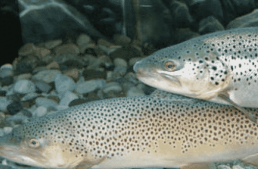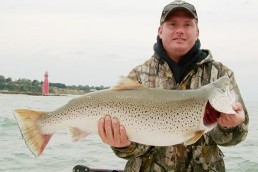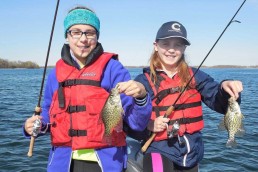The Springtime Bite is All About Browns … and Lakers
SHARE THIS POST
It was slightly overcast, and only three stars could be found in the southern sky. The calm water left a ripple trail behind each Yellow Bird as we set them out. As I let out a clown Husky Jerk Rapala and clipped on another planner board, the far one jerked back sharply—fish on. Then about 40 yards behind the planer board, a fish splashed and rolled in the darkness. I quickly finished setting the rod and put it in the holder as Rich grabbed the hot pole and guided the action to the center of our spread behind the boat. Several minutes later, I scooped the brown trout up and into the back of the boat.
Spring brings rains, and that means a couple of things to me. First of all, water levels were high with the wet summer we had in 2016 making rivers rise all season but even higher in the fall than back in early summer. Second, ice-out is the perfect time to target those “silvery footballs,” the brown trout, along shallow structure.
A long warm spell in January limited ice fishermen for a couple weeks, but what it really did was shorten winter. With a little less ice this year, I expect to see open boat landings and an earlier start to open-water angling. This is a welcome scenario to the anglers who live for those first days when they can slip their 18-inch trolling machines into Lake Michigan and do battle with chunky brown trout.
Since the zebra mussels invaded the Great Lakes we’ve seen water clarity improve. This means anglers need to shift outside to 15 to 30 feet of water. This opens up a whole new selection of baits to target with. Before, stickbaits dominated our selection in shallow water. Slowing down or turning in the shallows meant using floating stickbaits that would rise to the surface instead of sinking into the rocky bottom and snagging up. Now we can look to other options, like spoons and even small flashers and flies to target the browns.
Not only does the deeper water open up bait selection, it opens up the way we fish for browns. Now, downriggers and divers come into play. Before, these options were difficult because of how shallow we were fishing. This also makes it much easier to place our lures at specific depths and keep them in the strike zone. I also love running slide-divers for browns. By letting out 50, 60 or even 100 feet behind the divers and setting them, you present your baits not only at suspended depths, but also at back a ways behind the boat. Using long leads behind the downriggers will keep the baits a ways back from the boat. These are great places to run spoons or sometimes a flasher/fly combo.
Planner boards still play a big role in brown trout trolling. Just as in the shallow waters, these enable the angler to place baits wide from a boat and in front of browns that got spooked to wide and away from the path of the boat. These spread lures tend to run shallower to target the more aggressive browns cruising higher up in the water column. This is also a great place to run some stickbaits. Inner boards will often get large-lipped deep-divers or Husky Jerks while the outer boards will often get floaters.
Are you enjoying this post?
You can be among the first to get the latest info on where to go, what to use and how to use it!
As I mentioned earlier, sliding out a few feet and deeper enabled the use of more diverse bait selections. One of my favorite brown-trout baits is a spoon. When trolling in 6 to 10 feet in the rocky areas north of Algoma, it’s been difficult to keep the spoons from snagging in the rocks. In deeper water, it’s been much easier to run spoons without the fear of hanging up on structure. One way to ensure this is to play close attention to your GPS plotter screen and carefully follow the bottom contours.
Some of my favorite spoons for brown trout are the smaller lighter spoons. A couple that occupy the working side of my fluorocarbon are the R & R Razor Spoon in the “froggy patterns,” especially the Albino Frog and the Warrior Flutter Spoon in the perch patterns. But my favorite here is the Blue Perch. In the springtime browns cruise the shoreline hunting for tasty meals of smelt, alewives and the most abundant meal for the brown, the round goby. Baits imitating these not only in action, but also in color pattern, will often lure them to your net.
When targeting spring browns, pay close attention to water temperature. Areas with slight increases in temperature, even a degree or two, will tend to attract more bait and more active browns. Some of these patches of warmer water are areas that contain water that’s slightly cloudy or dirty. The cloudier water tends to absorb more sunlight and warm faster than the clear water. I like to mark these areas and make several passes through these spots, often producing several strikes with each pass.
A bonus in the spring is the lake trout. Lakers are known to travel the shallows in the spring to feed. Laker trout seem to take a liking to orange baits and when trolled. Not only are the lake trout caught in the colder spring waters and are great table fare, but when you get a fish on you never know what it will be.
Another factor with water clarity is using stealth. Not only do we need to be cautious to keep our tackle light, but we also need to apply 8- to 12-pound-test fluorocarbon for leaders.
With the crystal-clear waters, every little bit helps. Your careful preparation will lead to the chunky, silver, football-shaped browns tugging at the end of your line. And as the days get a little longer in March, the ice disappears and launches are opening up. Be ready to uncover the boat, bust out the tackle box, rods and reels, and get after some of the best fishing of the season.
MWO
SHARE THIS POST
Did you enjoy this post?
You can be among the first to get the latest info on where to go, what to use and how to use it!
Lee Haasch
Capt. Lee Haasch is a charter captain out of Algoma, Wis., with more than 45 years of Great Lakes angling and guiding experience. Haasch has been instructing anglers for over 30 years with education seminars and timely freelance articles.



